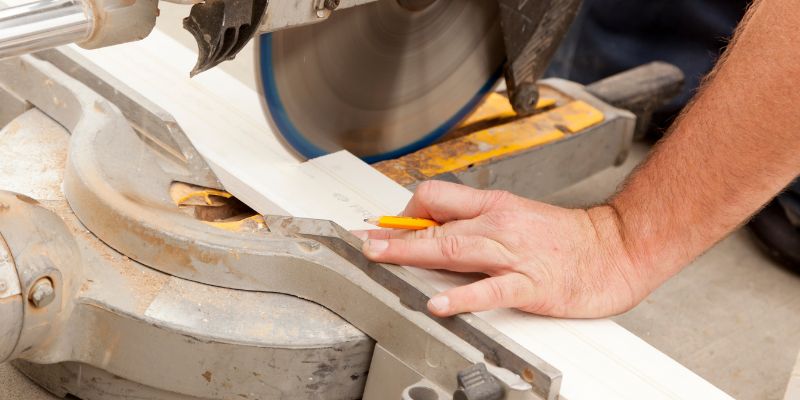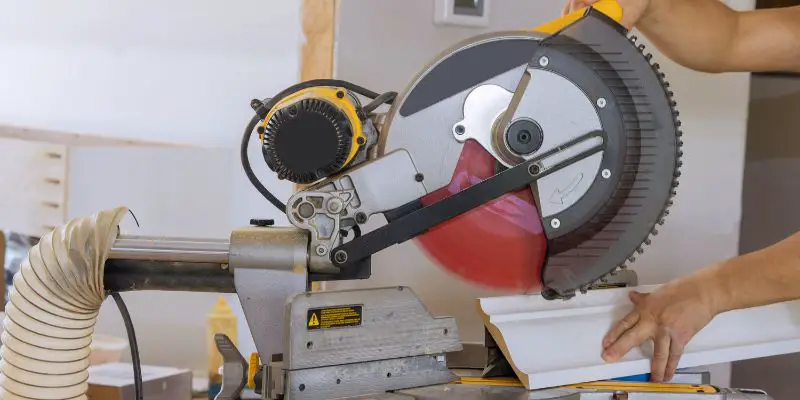To cut baseboard with a miter saw, measure and mark the length of the cut, position the baseboard against the fence, and lower the miter saw blade to make the cut at the marked angle. When it comes to cutting baseboard with a miter saw, it’s essential to follow the correct steps to ensure precise and clean cuts for a professional finish.
Whether you’re a DIY enthusiast or a professional carpenter, knowing how to use a miter saw to cut baseboard can help you achieve accurate measurements and angles for seamless joints and corners. In this guide, we’ll explore the essential steps and techniques for cutting baseboard with a miter saw, ensuring that you can complete your woodworking projects with confidence and precision.
Preparing To Cut Baseboard
Get ready to cut baseboard using a miter saw by measuring and marking the length, using a speed square as a guide, and securing the baseboard firmly in place. Make accurate cuts following the marked lines. Remember to use appropriate safety equipment and follow all safety precautions when using power tools.
Importance Of Measuring Twice And Cutting Once
Before starting to cut the baseboard with a miter saw, it’s crucial to measure the dimensions accurately. This simple step can prevent costly mistakes and wasted materials. Measuring twice and cutting once is a fundamental rule in carpentry that ensures precision and minimizes errors.
Selecting The Right Type Of Baseboard Material
Choosing the appropriate baseboard material is essential for achieving the desired look and durability. Different materials such as wood, MDF, and PVC offer various aesthetic and functional benefits. Selecting the right type of baseboard material that complements the room’s style and meets the project requirements is crucial for a successful outcome.
Safety Precautions When Using A Miter Saw
When using a miter saw to cut baseboard, safety should always be the top priority. Wearing protective gear, such as safety glasses and hearing protection, is essential. Additionally, ensuring that the miter saw’s blade guard is in place and the work area is clear of obstructions are critical safety precautions when using a miter saw.

Choosing Your Miter Saw
When it comes to cutting baseboards, choosing the right miter saw is crucial. Different types of miter saws serve different purposes, so selecting the best one for your baseboard project is essential for achieving clean and precise cuts.
Different Types Of Miter Saws For Baseboard Projects
There are several types of miter saws suitable for baseboard cutting, including:
- Standard Miter Saw
- Compound Miter Saw
- Sliding Compound Miter Saw
Each type of miter saw offers varying degrees of versatility, allowing users to make angled cuts and bevel cuts with ease. Consider the size of your baseboards and the complexity of your project when selecting the appropriate miter saw.
Blade Selection For Clean And Precise Cuts
Equally important as choosing the right miter saw is selecting the correct blade for your baseboard cutting needs. The right blade will ensure clean and precise cuts, enhancing the overall finish of your baseboard installation. Opt for a fine-toothed blade with at least 80 teeth to minimize chipping and tearing on the edges of the baseboard.
Adjusting Miter Saw Settings For Baseboard Cutting
Before making cuts, it’s crucial to adjust the miter saw settings to accommodate the specific angles and bevels required for baseboard cutting. Ensure the miter angle and bevel angle are accurately set according to your baseboard design, and use a stop block to maintain consistency in the length of each piece.
Exact Measurement For Perfect Cuts
When cutting baseboard with a miter saw, achieving exact measurements is crucial for ensuring perfect cuts. In this section, we will discuss how to mark the baseboard for accurate cutting, understand inside and outside corners, and use a t-bevel for angle transfers. These techniques will help you achieve precise measurements for seamless baseboard installations.
How To Mark The Baseboard For Accurate Cutting
Before cutting the baseboard, it’s essential to mark the measurements correctly. To ensure precise cuts, follow these steps:
- Measure the length needed for the baseboard and mark the cutting point using a pencil.
- Use a measuring tape or a carpenter’s square to double-check the marked measurements for accuracy.
- Make sure to clearly mark where the cuts will be made to avoid any errors during the cutting process.
Understanding Inside And Outside Corners
When working with baseboards, understanding the difference between inside and outside corners is crucial for accurate cutting. Here’s what you need to know:
- For inside corners, you will need to make a miter cut, where the ends of two baseboards join at an angle less than 90 degrees.
- For outside corners, a miter cut is also needed, but the ends join at an angle greater than 90 degrees.
Using A T-bevel For Angle Transfers
A t-bevel is a valuable tool for transferring angles accurately. Here’s how to use it:
- Place the t-bevel against the angle of the corner and lock it in place.
- Transfer the angle to the baseboard by aligning the t-bevel with the board’s edge and marking the angle.
- Double-check the angle measurement before making any cuts to ensure accuracy.
The Cutting Process
The cutting process is a crucial aspect of working with baseboards, and getting it right can make all the difference in achieving a professional and polished finish to your project. To ensure that your baseboards fit seamlessly in place, it’s essential to understand the correct techniques when using a miter saw for cutting. In this section, we’ll cover the step-by-step guide to cutting straight pieces, techniques for cutting inside and outside corners, and provide an ultimate guide for perfect cuts with a miter saw.
Step-by-step Guide To Cutting Straight Pieces
When cutting straight pieces of baseboard with a miter saw, follow these simple steps for precise and accurate cuts:
- Measure and mark your baseboard at the desired length using a pencil and measuring tape.
- Secure the baseboard firmly against the fence of the miter saw, ensuring that it is positioned flat against the saw table.
- Adjust the miter saw blade angle to 0 degrees for a straight cut.
- Turn the saw on, wait for it to reach full speed, and then carefully lower the blade to cut through the baseboard.
- Double-check that the cut is accurate and clean, as any imperfections can affect the fit and finish of the installation.
Techniques For Cutting Inside And Outside Corners
Cutting baseboards for inside and outside corners requires a different angle and approach to ensure a perfect fit. Follow these techniques for precision:
- For inside corners, set the miter saw to a 45-degree angle to the left for one piece and 45 degrees to the right for the complementary piece, ensuring a tight fit.
- When cutting baseboards for outside corners, set the miter saw to a similar 45-degree angle but position the pieces with the long points facing outward, yielding a clean and seamless joint.
- Always make test cuts on scrap pieces to verify that the angles and lengths are accurate before cutting your final baseboard pieces.
How To Cut Baseboard With Miter Saw: Ultimate Guide For Perfect Cuts
Cutting baseboards with a miter saw demands precision and attention to detail. By following our step-by-step guide and mastering the techniques for cutting both straight pieces and corners, you can achieve flawless and professional results every time.

Finishing And Installation Tips
When it comes to installing baseboards, the finishing touches and installation process are crucial in achieving a seamless and professional look. To ensure your baseboards are installed flawlessly, here are essential tips to follow during the finishing and installation process.
Smoothing Edges Post-cutting For Seamless Joints
Cutting baseboards with a miter saw can leave rough edges, which can affect the seamless joint when aligning the baseboards. To smoothen the rough edges, use fine-grit sandpaper or a sanding block to gently sand the edges until they are smooth and uniform. This step ensures that the baseboards fit together seamlessly, creating a polished and professional finish.
Best Practices For Aligning And Nailing Baseboards
When installing baseboards, it is essential to ensure they are properly aligned for a polished look. Use a level to ensure the baseboards are straight and even. Additionally, securing the baseboards in place with nails should be done with care to avoid splitting the wood. Pre-drilling holes before nailing can prevent splitting and ensure a secure fit without causing damage to the baseboards.
Caulking And Painting For A Professional Finish
After the baseboards are installed, caulking the gaps between the baseboards and the wall is essential to create a seamless and polished look. Choose a high-quality caulk that matches the color of the baseboards for a professional finish. Once the caulking is complete, painting the baseboards to match the room’s decor will provide a cohesive and polished appearance. Ensure each coat of paint is applied evenly for a smooth and professional finish.
Frequently Asked Questions On How To Cut Baseboard With Miter Saw
How Do I Choose The Right Miter Saw For Cutting Baseboard?
When choosing a miter saw for cutting baseboard, consider the size, angle range, and power. Look for a saw with a high bevel capacity for making compound cuts and a laser guide for precision. A dual bevel feature will also simplify the process by allowing cuts in both directions without flipping the lumber.
What Are The Essential Safety Precautions When Cutting Baseboard With A Miter Saw?
Before cutting baseboard with a miter saw, ensure proper eye protection, use a dust mask, and secure the baseboard firmly. Keep your hands at a safe distance from the blade and never remove the safety guard. Always follow the manufacturer’s instructions and use push blocks or push sticks to maintain a safe distance from the blade.
What Type Of Blade Should I Use For Cutting Baseboard With A Miter Saw?
For cutting baseboard, use a fine-tooth blade with at least 80 teeth to ensure smooth and precise cuts. Consider a blade with an anti-vibration design to reduce noise and achieve cleaner cuts. Make sure the blade is sharp and suitable for cutting wood, and always follow the manufacturer’s recommendations for blade selection.
Conclusion
Learning how to cut baseboard with a miter saw can greatly enhance your home improvement skills. With the right tools and techniques, you can achieve precise and professional-looking results that will elevate the overall aesthetic of your space. So, don’t hesitate to pick up your miter saw and start cutting!



One thought on “How to Cut Baseboard With Miter Saw: Ultimate Guide for Perfect Cuts”